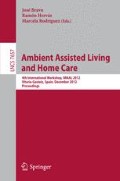Abstract
Virtual Reality (VR) could be interesting tool to combat obesity and sedentariness in children. Objective is to study possibilities of VR during aerobic exercise in children obese and normal weight . Physiological (cardiovascular and metabolic response with biomedical sensors (smart fabrics TIAS)) and psychological responses have been collected. First study (n=90), a commercial platform was tested as support to aerobic exercise in a treadmill. Results showed more physiological effort by obese group and limitations to measure effort perception with Borg scale especially in obese group. In second study (n=126) a new VR platform was developed (VREP) and tested ,all the boys completed both conditions (same Aerobic exercise with/without support VR). 59.5% felt more effort in the traditional condition The vast majority of the participants liked the idea of combining physical activity with VR as a form of treatment to increase physical activity.
Access this chapter
Tax calculation will be finalised at checkout
Purchases are for personal use only
Preview
Unable to display preview. Download preview PDF.
References
Janssen, I., LeBlanc, A.G.: Systematic review of the health benefits of physical activity and fitness in school-aged children and youth. The International Journal of Behavioral Nutrition and Physical Activity 7(06), 40 (2010)
Janssen, I.: Physical activity guidelines for children and youth. Applied Physiology Nutrition and Metabolism 32(S2E), S109–S121 (2007)
Pavey, T.G., Taylor, A.H., Fox, K.R., Hillsdon, M., Anokye, N., Campbell, J.L., Foster, C.: Effect of exercise referral schemes in primary care on physical activity and improving health outcomes: systematic review and meta-analysis. Bmj 343(nov04 2), d6462 (2011)
"Skip" Rizzo, A., Lange, B., Suma, E.A., Bolas, M.: Virtual reality and interactive digital game technology: new tools to address obesity and diabetes. Journal of Diabetes Science and Technology Online 5(2), 256–264 (2011)
Strickland, D.: A virtual reality application with autistic children. PresenceTeleoperators and Virtual Environments 5(3), 319–329 (1996)
Bouchard, S.: Could virtual reality be effective in treating children with phobias? Expert Review of Neurotherapeutics 11(2), 207–213 (2011)
Mestre, D.R., Dagonneau, V.: Does virtual reality enhance exercise performance, enjoyment, and dissociation? an exploratory study on a stationary bike apparatus. Presence Teleoperators and Virtual Environments 20(1), 1–14 (2011)
Der-Karabetian, A., Stephenson, K., Poggi, T.: Sex differences in exercise motivation and body-image satisfaction among college students. Perceptual and Motor Skills 83(2), 723–732 (1998)
Guixeres, J., Zaragoza, I., Alcaniz, M., Gomis-Tena, J., Cebolla, A., Zaragozá, I., Alcañiz, M.: A new protocol test for physical activity research in obese children (etiobe project). Stud. Health Technol. Inform. 144, 281–283 (2009)
Meyer, L.J.: The impact of virtual reality-enhanced exercise equipment on adherence to daily step goals. ProQuest Information & Learning (2009)
Bar-Or, O., Rowland, T.W.: Pediatric exercise medicine: from physiologic principles to health care application, p. xviii, 501 p. Human Kinetics, Champaign (2004)
Author information
Authors and Affiliations
Editor information
Editors and Affiliations
Rights and permissions
Copyright information
© 2012 Springer-Verlag Berlin Heidelberg
About this paper
Cite this paper
Guixeres, J. et al. (2012). Could Virtual Reality Be an Effective Tool to Combat Obesity and Sedentariness in Children? Results from Two Research Studies. In: Bravo, J., Hervás, R., Rodríguez, M. (eds) Ambient Assisted Living and Home Care. IWAAL 2012. Lecture Notes in Computer Science, vol 7657. Springer, Berlin, Heidelberg. https://doi.org/10.1007/978-3-642-35395-6_20
Download citation
DOI: https://doi.org/10.1007/978-3-642-35395-6_20
Publisher Name: Springer, Berlin, Heidelberg
Print ISBN: 978-3-642-35394-9
Online ISBN: 978-3-642-35395-6
eBook Packages: Computer ScienceComputer Science (R0)

